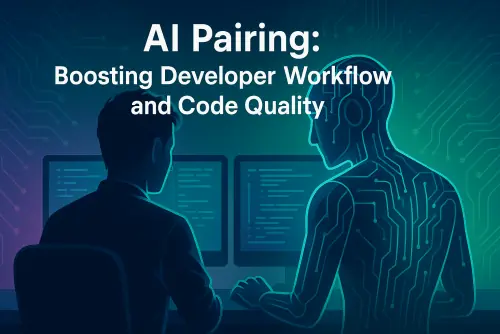Pair programming, a practice where two developers work together at one workstation, has long been valued for its ability to improve code quality, facilitate knowledge sharing, and catch errors early. Now, imagine one of those developers is an advanced Artificial Intelligence. This is the burgeoning reality of AI Pair Programming, a paradigm set to significantly boost developer workflows. This concept is an evolution of vibe coding and is related to how coding agents are rethought with RAG.
AI pair programmers, often powered by sophisticated Large Language Models (LLMs) (like those behind GitHub Copilot, ChatGPT, or Tabnine), are more than just fancy auto-complete tools. They can understand context, generate code, suggest solutions, explain complex concepts, and even help with debugging and testing. For a look at debugging specifically, see our article on AI-assisted debugging.
What is AI Pair Programming?
Traditional pair programming involves two developers working together at one workstation. One, the "driver," writes code while the other, the "navigator," reviews each line, suggests improvements, and plans the next steps.
AI pair programming extends this concept by having a developer collaborate with an AI assistant. Tools like GitHub Copilot, Amazon CodeWhisperer, or Cursor act as intelligent navigators, offering real-time code suggestions, identifying potential bugs, generating boilerplate code, and even helping with documentation.
"Think of your AI pair programmer as an incredibly fast, knowledgeable, and tireless assistant who's always ready to help you write better code, faster."
Key Benefits of AI Pairing
Integrating AI into your pairing sessions offers a multitude of advantages:
Accelerated Development Cycles:
- Rapid Prototyping: AI can quickly generate a functional skeleton for new features or components, allowing developers to focus on complex logic and refinement.
- Boilerplate Reduction: Mundane tasks like writing getters/setters, basic unit tests, or configuration files can be offloaded to the AI, saving valuable developer time.
- Faster Debugging: Some AI tools can analyze code for common errors or suggest fixes for existing bugs, reducing the time spent on troubleshooting.
Enhanced Code Quality:
- Real-time Feedback: AI provides instant suggestions for improving code clarity, adhering to best practices, and optimizing performance.
- Consistency: AI can help enforce coding standards and conventions across a project, leading to more maintainable code.
- Reduced Cognitive Load: By handling routine tasks, AI allows developers to concentrate on higher-level architectural decisions and problem-solving.
Improved Learning and Onboarding:
- Learning New Technologies: AI can provide examples and explain concepts when working with unfamiliar languages, frameworks, or libraries.
- Knowledge Sharing: AI tools often learn from vast codebases, exposing developers to different approaches and solutions.
Debunking Common Myths:
- Myth: AI will replace developers.
- Reality: AI is a tool to augment developer capabilities, not replace them. Critical thinking, problem-solving, and architectural design remain human-led.
- Myth: AI-generated code is unreliable.
- Reality: While AI-generated code requires review, it often serves as a strong starting point. The developer's role shifts to include careful validation and refinement.
- Myth: AI will replace developers.
Accelerated Learning and Onboarding:
- Junior developers can learn rapidly by observing AI suggestions and asking for explanations of complex code or concepts. The AI can act as an interactive tutor, providing instant feedback and guidance. This could even extend to understanding and generating smarter documentation.
Improved Code Quality and Consistency:
- Real-time Feedback: AI provides instant suggestions for improving code clarity, adhering to best practices, and optimizing performance.
- Consistency: AI can help enforce coding standards and conventions across a project, leading to more maintainable code.
Enhanced Problem Solving & Ideation:
- Stuck on a complex problem? AI can offer alternative approaches, suggest algorithms, or break down the problem into smaller, manageable parts. It can act as a sounding board for ideas. This is part of achieving better developer productivity.
Real-World Examples
- Startup Sprint: A small startup used an AI pair programmer to build out their MVP's backend. The AI generated most of the CRUD operations and API endpoints, allowing the lean team to launch three weeks ahead of schedule.
- Legacy Code Refactor: A developer tasked with refactoring a complex legacy module used an AI assistant to understand obscure code sections, suggest modern alternatives, and generate unit tests, significantly reducing the risk and effort involved.
Best Practices for Effective AI Pairing
To make the most of AI pair programming:
- Be Specific with Prompts: Clearly define what you want the AI to do. Vague prompts lead to generic or unhelpful suggestions.
- Iterate and Refine: Don't expect perfect code on the first try. Use the AI's output as a starting point and refine it. This iterative process is similar to how machine learning models are trained.
- Always Review and Test: AI-generated code is not infallible. Thoroughly review and test any code produced by an AI assistant to ensure it's correct, secure, and efficient. Evaluate its performance rigorously.
- Understand Limitations: Be aware of the AI's knowledge cut-off and potential biases. It might not always be up-to-date with the latest libraries or best practices. This awareness is crucial for ethical AI development.
- Maintain Human Oversight: AI is a tool to augment human developers, not replace them. The developer is still responsible for the final product and a potential push back from developers needs to be managed.
The Future of Collaboration
AI pair programming is rapidly evolving, and its integration into developer workflows is becoming increasingly seamless. By embracing these tools thoughtfully, developers can significantly enhance their productivity, creativity, and overall job satisfaction. It's a step towards a future where human ingenuity and artificial intelligence collaborate to build better software, faster. For a broader view, consider the impact of AI on UI/UX design and other related fields.
Have you tried AI pair programming? What are your experiences and tips?
Have you tried AI pair programming? Share your experiences and tips in the comments below!

Comments